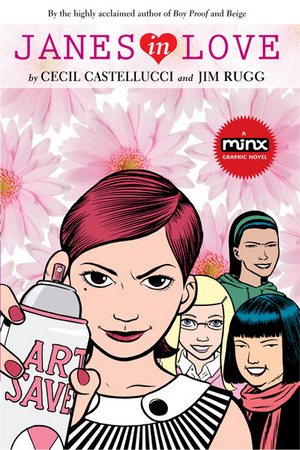- Comics
- Comics Reviews
- Manga
- Comics Reviews
- European Comics
- News
- Comics News
- Press Releases
- Columns
- Spotlight
- Digital Comics
- Webcomics
- Cult Favorite
- Back Issues
- Webcomics
- Movies
- Toys
- Store
- More
- About
By Leroy Douresseaux
September 29, 2008 - 11:11
 |
| Jim Rugg's cover for "Janes in Love." |
The new “Young Adult” (YA) graphic novel, Janes in Love, is one of 2008’s premiere graphic novels, and I’d certainly shortlist it for year-end “best of” honors.
In the inaugural book from DC Comics’ Minx imprint, The Plain Janes, YA author Cecil Castellucci (Boy Proof, The Queen of Cool) and comic book artist Jim Rugg (Street Angel) introduced readers to the character, Jane Beckles. Jane was a resident of Metro City (a stand-in for New York City, perhaps) when a terrorist act sent her and her family running to the suburban haven of Kent Waters.
Jane has a difficult time fitting in at the fairly uptight Buzz Aldin High School, but she meets three other girls named “Jane,” and that eventually gives birth to P.L.A.I.N., People Loving Art in Neighborhoods. Committing acts that many consider to be vandalism in the least, P.L.A.I.N. paints and decorates the streets, parks, buildings, etc. of Kent Waters in the naïve belief that they can use art to bring beauty into the world and dampen down the fear and loathing. Art saves… saves lives… saves the world…
In Janes in Love, Jane and the rest of her artsy misfits are back, still boldly committing their art attacks, even after the events that ended the first book. Now, however, teen love, in all its pungent flavors, has reared its head, and the “Ides of March” Dance (which replaces the not-cool Valentine’s Day dance), means the girls need dates to the dance. The girls struggle with this boyfriend thing, and soon they’re also at odds with each other. In the meantime, a new terrorist act sends Jane’s mother over the edge, and not only does her parents’ marriage become strained, but so does her relationship with them. Things should be looking up when Janes decides to seek an arts grant to take P.L.A.I.N. to the next level, but suddenly everyone seems down on her.
The Plain Janes focused on the hopefulness of Jane and her friends placed against the backdrop of a world where the adults seemed possessed by a sense of creeping dread. Janes in Love hits upon similar themes. The youthful exuberance of Jane Beckles is personified by a love for life, a lust for art that can bring beauty to the world, and an insistent, yet gentle determination to bring people together regardless of ideologies and beliefs. High school cliques and status don’t matter, either.
Art certainly doesn’t make everything perfect, especially Jane’s life. Jane and the rest of the students at Buzz Aldin High have their own issues, where being different or having a different way of doing things can cause friction, even among friends. Thus, writer Cecil Castellucci never pretends that the lives of these young artists are so pure and perfect. On the other hand, at least the kids work through obstacles – the kids are alright, while the adults are frozen. Castellucci casts her eyes at the adults who mostly live in fear of anything that is so different that its existence stands up and challenges the sameness of what seems as normal in Kent Waters – such as the P.L.A.I.N. art pranks. Castellucci’s message of hope, love, understanding, and the understanding of our differences seems like a divine message. This is especially true in a culture where so much is viewed through the lens of cynicism and people’s fear of the ever-present boogeymen of random acts of violence and terror.
Amongst comic book fans, there is much appreciation for artist George Perez’s (Crisis on Infinite Earths, New Teen Titans) ability to draw a unique face for each character, even on a page that might feature dozens of faces. The talented Jim Rugg can do the same, but in his clean style that is more like newspaper and magazine cartooning and animation than it is like the hyper-realistic styles of many comic book artists. If Castellucci’s script celebrates a world of beauty in all things different and unique, then, Rugg proficiently captures that in his comic book illustrations for Janes in Love.
Janes in Love celebrates young love, but it is a romance that goes beyond merely dating. It is a love of both the humanity that makes us the same and the diversity that makes each of us a unique being. The beauty in what makes us different accentuates those connections that mark us as the same, one group - humans. In Janes in Love, we learn that when art teaches us that, art saves.
A